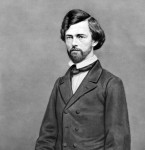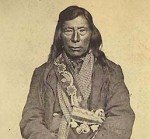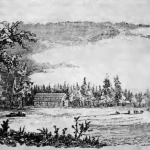Governor Stevens sent James Doty to notify the tribes of a series of councils to be held in May, 1855, the first of which was to be attended by the Yakima, Cayuse, Walla Walla, and Nez Perce. Kamiakin, chief of the Yakima, selected as the council ground a place in the Walla Walla Valley not far from Waiilatpu. Governor Stevens and Superintendent Palmer were escorted there by Lt. Archibald Gracie and 47 dragoons. The presents for the chiefs were stored at Ft. Walla Walla. Comfortable arrangements were made at the council grounds and on May 24th the first of the Indians arrived. They were the Nez Perce under Chiefs Lawyer and Lookingglass. They camped near the Com-missioners whom they entertained with tribal dances. On the 26th the Cayuses and Walla Walla came and they, too, danced for the Commissioners. May 28th came and with it the Yakima. All told there were about 5000 people present counting com-missioners, dragoons, chiefs, warriors, squaws, and children. It took until the 30th to get down to the business of the council.
The speeches dragged on for days. There was almost un-animous sentiment against sale of their lands by the chiefs. Kamiakin, head chief of the Yakima, and Chief Owhi, his half-brother, opposed the plan as did Old Joseph and Lookingglass of the Nez Perce. The Cayuses were against the sale and even Peu-peu-mox-mox, traditional friend of the whites, refused to be a party to the Commissioners’ offer. Lawyer, head chief of the Nez Perce, was alone in his willingness to sell.
Lawyer told Stevens that a plot was afoot to massacre Stevens and his escort and that .the attempt only awaited concurrence by more of the tribes. He also said that the contemplated massacre was to be the signal for the capture of the military post at The Dalles and a war of extinction of the whites.
Lawyer offered to move his family and pitch his lodge in the midst of Stevens camp which was done. Stevens later credited Lawyer with having prevented the attack. Also, in later years, the tribes accused of this plot asserted that there was no basis for Lawyer’s accusation, saying that it had been a political move on Lawyer’s part to share more favorably from the treaty negotiations.
Perhaps the main stumbling block was a provision that after the sale, all tribes represented were to share a common reservation. Finally the Commissioners conceded that point and offered separate tribal reservations and with that concession all chiefs except Kamiakin signed the treaty on June 11, 1855.
The Nez Perce tribe received $200,000 payable in installments over a term of years, and a large reservation tract. The Walla Walla and the Cayuses combined and accepted their reservation in the Umatilla Valley and $150,000; the Yakima took as their reservation the best land south of the Yakima River and $200,000. They were all assured of schools, mills, and equipment, and the attitude of the chiefs after the signing was one of friendliness and cordiality. The presents were distributed and W. H. Tappan was appointed Agent to the Nez Perce, R. R. Thompson to the Cayuses and Walla Walla, and A. J. Bolon to the Yakima.
On June 16th Governor Stevens departed to treat with the Colville, Coeur d’Alene, Spokane, and other Northeastern Washington tribes. Palmer went to The Dalles where he purchased land and concluded treaties with the tribes located between the Powder River and the Cascades. As a result of Palmer’s treaties the Oregon tribes involved acquired the Warm Springs Reservation between the Deschutes River and the Cascades.
It should be remembered that after the Walla Walla treaty in June, that Governor Stevens went to treat with the more northern tribes of Washington Territory. It must also be recalled that at the time the Territory embraced portions of Idaho and Western Montana. While Stevens was thus occupied far from the seat of government, C. H. Mason was acting Governor.
During the late summer and early fall of 1855 several citizens of the Puget Sound country were murdered by Yakima while traveling to or from the mines in the Colville district. Occasional travelers from elsewhere were murdered while passing through the land of the Yakima. News of these outrages reached A. J. Bolon, sub-agent for the Yakima, while on his way to meet Governor Stevens in the Spokane Indian country. Bolon turned back from his proposed meeting with the Governor, having decided to go to Father Brouillet’s mission, near which Chief Kamiakin lived, and ask the Chief first-hand about the murders. Bolon decided to travel alone to show the Yakima that their sub-agent believed in them. Hence, we do not know exactly what happened except from subsequent stories of less hostile Indians.
The Indians surrounded the hill and at daybreak resumed the attack which continued all day. That night a messenger was sent to The Dalles for help and to acquaint Major Rains with the sad plight of Major Haller’s command. On the 8th, which was the third day of the battle, suffering from thirst was intense. Most of the horses were turned loose, only enough being kept to carry the wounded and the ammunition. The howitzer was buried, the baggage and surplus supplies were burned, and the troop prepared to set out on a retreat in the direction of The Dalles. The contingent was divided into two parties, the advance section which included the wounded being in command of Major Haller, and the rear guard, under Captain Russell. Haller’s section set out undetected by the Indians but they lost the trail and lighted signal fires to let the rear guard know their location. The fires were, of course, notice to the Indians, and, unhappily, were unseen by Captain Russell’s command.
The Indians pursued Haller and his men, who kept up a running fight until within 25 miles of The Dalles where they were met by Lieutenant Day of the 3rd Artillery with 45 men. The forces joined and erected a block-house on the Klickitat River. Lieutenant Slaughter and his 50 men, traveling from Ft. Steilacoom had crossed the Cascades at Natches Pass. Upon reaching the east side of the range he found large numbers of Indians prepared for war and heard of Major Haller’s defeat. So Slaughter retreated, recrossing the range to the west side. Major Haller lost five men killed and 17 wounded, besides a large quantity of supplies. The Indian losses were estimated at 40 killed.
Major Haller considered that 1000 soldiers would be needed to subdue the Indians. From the regulars at The Dalles 19 officers and 315 men, both infantry and artillery, with three howitzers were sent into the field. From Ft. Steilacoom all except a small guard were dispatched under Captain Maloney. Nineteen Dragoons under Lieutenant Phil Sheridan were sent from Vancouver. But the aggregate of all these regulars was not enough for the campaign. Major Rains called upon Acting Governor Mason for two companies of volunteers and upon Governor Curry for four companies. Adequate supplies of arms were obtained at Vancouver Barracks to equip two of the Oregon companies. The rest of the Oregon Volunteers outfitted themselves. Acting Governor Mason petitioned the captains of two government ships then in Puget Sound for assistance. The ships’ commanders responded.
One of the Washington companies was deployed at various strategic points west of the Cascades as a defense measure in case of Indian attacks and the other made preparations to go to the relief of Governor Stevens, who was still somewhere in Northern Idaho or Western Montana, unwilling to risk his way through the hostile country.
On October 11, 1855, Governor Curry issued a proclamation calling for the enrollment of eight companies of mounted volunteers. While this was twice the number requested by Major Rains, Governor Curry had required that the Oregon volunteers were to be an independent command, but would work with the regular troops. Just why that restriction was inserted by Governor Curry may be a matter for debate, but it must be borne in mind that the attitude of General Wool toward volunteers was still fresh in the memories of all territorial residents and it was a mark of a changing attitude for a regular army officer to ask for volunteer help.
Governor Curry appointed recruiting officers and enlistments were so numerous that eventually ten companies were enrolled.
Major Rains left for the seat of war on October 30th. With him were all the available regulars and two companies of volunteers who had been enlisted in the Federal service. On November 4th he was joined by four companies of Oregon Volunteers under the command of Colonel J. W. Nesmith. The official name of Nesmith’s force was the First Regiment of Oregon Mounted Volunteers. November 7th found them in the Yakima country and on the 8th they engaged in the first skirmishes. The Indians were not favored with overwhelming numbers as was the case in their fight with Major Haller’s previous command. Now the number of soldiers equaled that of the hostiles. They went up the Yakima River with the troops in pursuit and took up a position on the heights overlooking a point where the river flowed through rather precipitous walls. A portion of the regulars under Major Haller and Captain Augur charged the position and the Indians fled. Next day contact was again made, followed by an unsuccessful effort by part of the Oregon Volunteers under Major Ambrose N. Armstrong to surround the Indians. The attempt might have succeeded but for the fact that the wrong point was selected for the assault and the Indians escaped.
A few miles farther up the Yakima Valley was a Catholic Mission, called Ahtanum Mission, and to that place the troops moved. The mission had been vacated, but there Major Rains received a letter from Chief Kamiakin, written by the missionary Father Pandozy. In the letter Kamiakin offered friendship but on terms dictated by himself. On November 13th Major Rains addressed his reply which was a masterly example of directness as well as of understanding of Indian character. In it he laid down the dictum that he was in the field to exterminate the Yakima because of the wanton murders and the repudiation of the treaty made with Governor Stevens and Superintendent Palmer. Rains signed the letter with two titles, first as “Major, United States Army” and then as “Brigadier-General Washington Territory.” Major Rains had accepted the latter commission from Acting Governor Mason because the Oregon Volunteers had a Brigadier-General of their own John K. Lamerick, and while Major Rains was acknowledged by all to be the logical commander in the field, embarrassment because of rank was obviated by the Washington commission. Later Major Rains was criticized by General Wool in characteristic fashion for having accepted Mason’s commission, General Wool considering it beneath the dignity of a regular army officer to accept a commission from a Territorial official.
The first snows of the winter had fallen to a considerable depth at the higher elevations. The Indians had scattered and Rains decided to return his regular troops to The Dalles, which he did. From there the Major went to Vancouver Barracks to report to General Wool, arriving on November 24th. Colonel Nesmith marched his Oregon Volunteers to Walla Walla.
In the meantime other events of importance had been transpiring.




